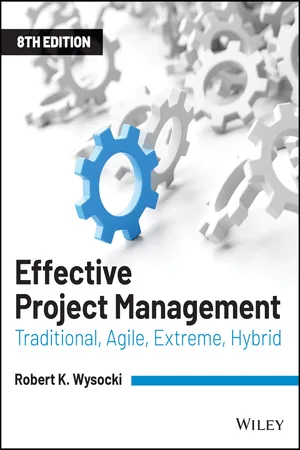
- English
- ePUB (mobile friendly)
- Available on iOS & Android
About this book
The popular guide to the project management body of knowledge, now fully updated
Now in its eighth edition, this comprehensive guide to project management has long been considered the standard for both professionals and academics, with nearly 40, 000 copies sold in the last three editions! Well-known expert Robert Wysocki has added four chapters of new content based on instructor feedback, enhancing the coverage of best-of-breed methods and tools for ensuring project management success.
With enriched case studies, accompanying exercises and solutions on the companion website, and PowerPoint slides for all figures and tables, the book is ideal for instructors and students as well as active project managers.
- Serves as a comprehensive guide to project management for both educators and project management professionals
- Updated to cover the new PMBOK® Sixth Edition
- Examines traditional, agile, and extreme project management techniques; the Enterprise Project Management Model; and Kanban and Scrumban methodologies
- Includes a companion website with exercises and solutions and well as PowerPoint slides for all the figures and tables used
- Written by well-known project management expert Robert Wysocki
Effective Project Management, Eighth Edition remains the comprehensive resource for project management practitioners, instructors, and students. (PMBOK is a registered mark of the Project Management Institute, Inc.)
Frequently asked questions
- Essential is ideal for learners and professionals who enjoy exploring a wide range of subjects. Access the Essential Library with 800,000+ trusted titles and best-sellers across business, personal growth, and the humanities. Includes unlimited reading time and Standard Read Aloud voice.
- Complete: Perfect for advanced learners and researchers needing full, unrestricted access. Unlock 1.4M+ books across hundreds of subjects, including academic and specialized titles. The Complete Plan also includes advanced features like Premium Read Aloud and Research Assistant.
Please note we cannot support devices running on iOS 13 and Android 7 or earlier. Learn more about using the app.
Information
Part I
Understanding the Project Management Landscape
CHAPTER 1
What Is a Project?
CHAPTER LEARNING OBJECTIVES
- Express a business need in terms of a problem or opportunity
- Understand how goal and solution can be used to define project types
- Appreciate the challenges of the complex project landscape
- Define a project, program, and portfolio
- Define a complex project
- Understand the Scope Triangle
- Envision the Scope Triangle as a system in balance
- Prioritize and apply the Scope Triangle for improved change management
- Know the importance of classifying projects
- Understand the project landscape and how it is applied
UNIQUE VALUE PROPOSITIONS
Defining a Project
DEFINITION: PROJECT
Sequence of Activities
Unique Activities
Table of contents
- Cover
- Table of Contents
- Preface
- Introduction
- Part I: Understanding the Project Management Landscape
- Part II: Traditional Project Management
- Part III: Complex Project Management
- APPENDIX A: Terms and Acronyms
- APPENDIX B: Case Study: Workforce and Business Development Center
- APPENDIX C: Case Study: Pizza Delivered Quickly (PDQ)
- APPENDIX D: Cited References
- APPENDIX E: What's on the eiipbs.com Website?
- Index
- End User License Agreement